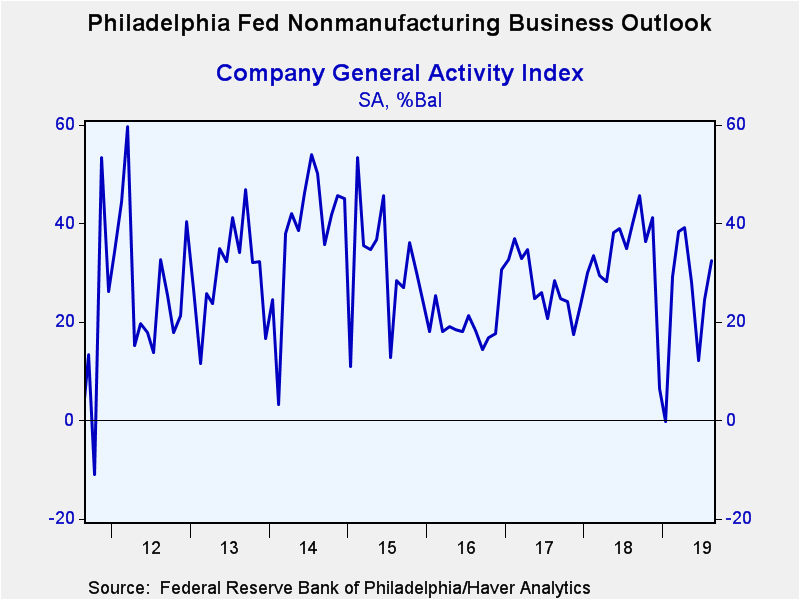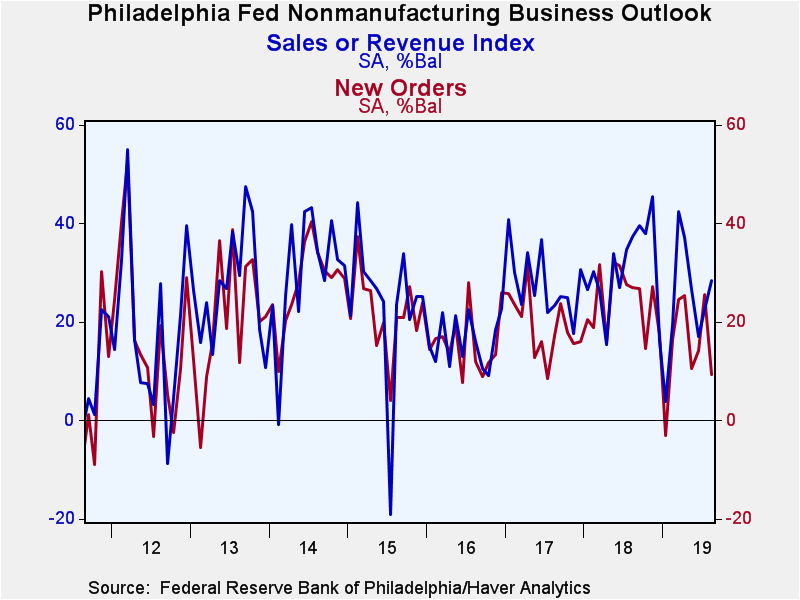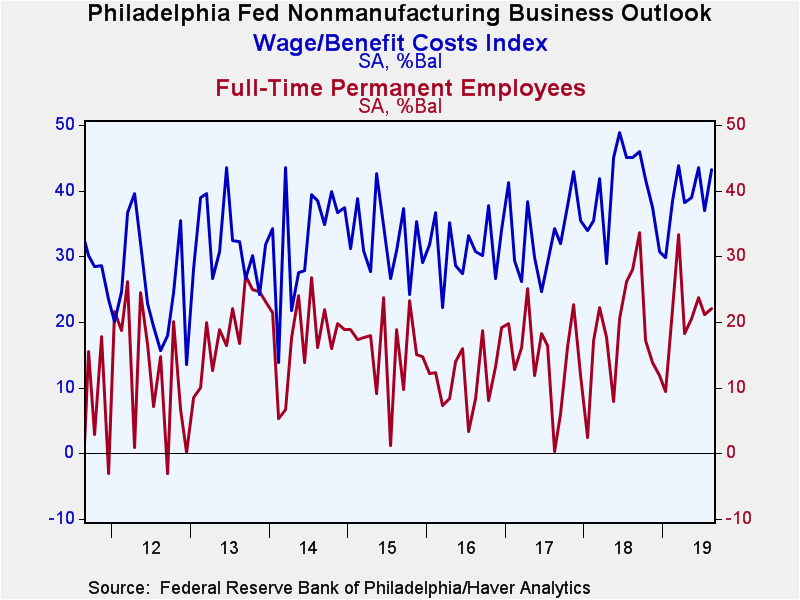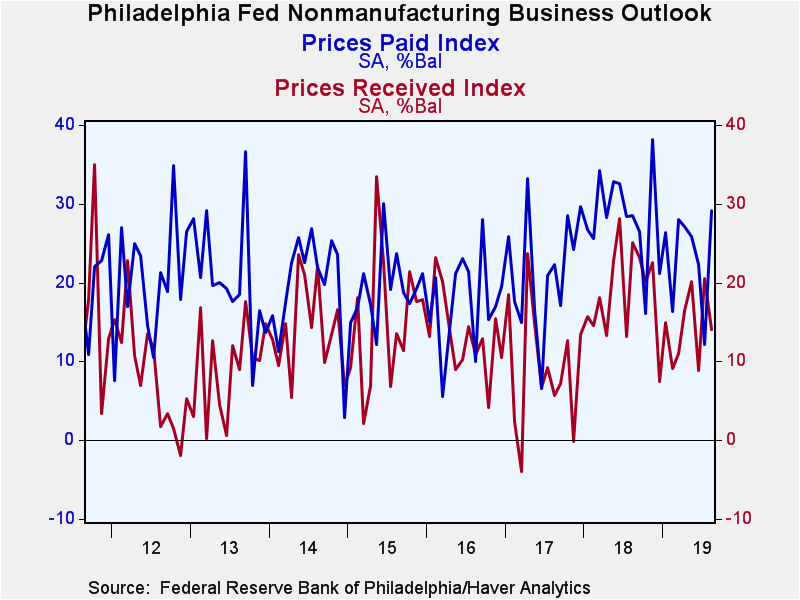 Global| Aug 20 2019
Global| Aug 20 2019Philadelphia Fed Nonmanufacturing Business Activity Strengthens
by:Tom Moeller
|in:Economy in Brief
Summary
The Federal Reserve Bank of Philadelphia reported that its Nonmanufacturing Business Index of current conditions at the company level rose to 32.5 in August from 24.6 in July. It was the highest reading since April. Deteriorating, [...]
The Federal Reserve Bank of Philadelphia reported that its Nonmanufacturing Business Index of current conditions at the company level rose to 32.5 in August from 24.6 in July. It was the highest reading since April. Deteriorating, however, was the index of expected general activity which declined to 26.8 and reversed the prior month's increase. The general business activity reading for the region collapsed to -0.7 from July's 21.8, and was the lowest figure since October 2011.
The components of the company general activity index were mixed this month. Sales rose to 28.5, the highest level since April. An increased 49% of firms reported higher sales while a steady 20% reported a decline. Countering this rise was a sharp decline in new orders index to 9.4 from the recent high of 25.5 in July. Unfilled orders collapsed to 1.1, the lowest level since October. Inventories were fairly steady m/m at 5.8 but were up sharply from three months earlier.
The labor market measures were fairly steady in August. Full-time permanent employment was a net reading of 22.1 compared to 21.1 in July. Twenty-eight percent of firms reported increased hiring while six percent indicated a decline. Part-time/temporary employee hiring also was steady m/m at 13.5, but that was below April's high of 24.3. The workweek figure continued a decline to 17.4 from the March high of 29.9. The wages & benefits measure rose to 43.2, but has moved erratically sideways for most of this year.
Pricing power improved. The index of prices paid surged to 29.2 this month, the highest level in nine months. Thirty-six percent of firms reported higher prices while seven percent indicated a decline. Prices received eased, however, to 14.0, and have been moving sideways for most of the year.
The capital expenditure measures were mixed. The physical plant measure declined m/m to 15.9. That's above the April low of 13.0, but below the early-2017 high of 35.3. The equipment & software expenditure reading increased to 29.7, its highest level in 12 months.
The Philadelphia Fed figures are diffusion indexes which are calculated by subtracting the percent of respondents reporting decreases in business activity from those reporting improvement. So, readings above zero indicate more positive than negative responses. These indexes have a good correlation with growth in the series covered. The data are available in Haver's SURVEYS database.
| Federal Reserve Bank of Philadelphia: Nonmanufacturing Business Outlook Survey (Diffusion Index, SA) | Aug | Jul | Jun | Aug'18 | 2018 | 2017 | 2016 |
|---|---|---|---|---|---|---|---|
| General Activity - Company | 32.5 | 24.6 | 12.2 | 39.9 | 33.6 | 27.3 | 19.7 |
| New Orders | 9.4 | 25.5 | 14.3 | 27.1 | 24.3 | 19.1 | 15.8 |
| Sales or Revenue | 28.5 | 22.5 | 17.0 | 37.4 | 30.9 | 27.9 | 16.1 |
| Inventories | 5.8 | 8.6 | 2.9 | 8.6 | 5.2 | 3.8 | 4.3 |
| Number of Full-Time Permanent Employees | 22.1 | 21.1 | 23.8 | 28.0 | 18.2 | 14.8 | 11.7 |
| Part-Time/Temporary/Contract Employees | 13.5 | 11.6 | 20.2 | 18.4 | 15.6 | 12.4 | 11.8 |
| Prices Paid | 29.2 | 12.2 | 22.3 | 28.5 | 28.3 | 21.4 | 17.6 |
| Wage & Benefit Costs | 43.2 | 37.0 | 43.6 | 45.0 | 40.0 | 33.4 | 31.2 |
| Expected General Activity - Company | 26.8 | 36.0 | 26.4 | 50.7 | 50.2 | 50.1 | 43.2 |
Tom Moeller
AuthorMore in Author Profile »Prior to joining Haver Analytics in 2000, Mr. Moeller worked as the Economist at Chancellor Capital Management from 1985 to 1999. There, he developed comprehensive economic forecasts and interpreted economic data for equity and fixed income portfolio managers. Also at Chancellor, Mr. Moeller worked as an equity analyst and was responsible for researching and rating companies in the economically sensitive automobile and housing industries for investment in Chancellor’s equity portfolio. Prior to joining Chancellor, Mr. Moeller was an Economist at Citibank from 1979 to 1984. He also analyzed pricing behavior in the metals industry for the Council on Wage and Price Stability in Washington, D.C. In 1999, Mr. Moeller received the award for most accurate forecast from the Forecasters' Club of New York. From 1990 to 1992 he was President of the New York Association for Business Economists. Mr. Moeller earned an M.B.A. in Finance from Fordham University, where he graduated in 1987. He holds a Bachelor of Arts in Economics from George Washington University.










